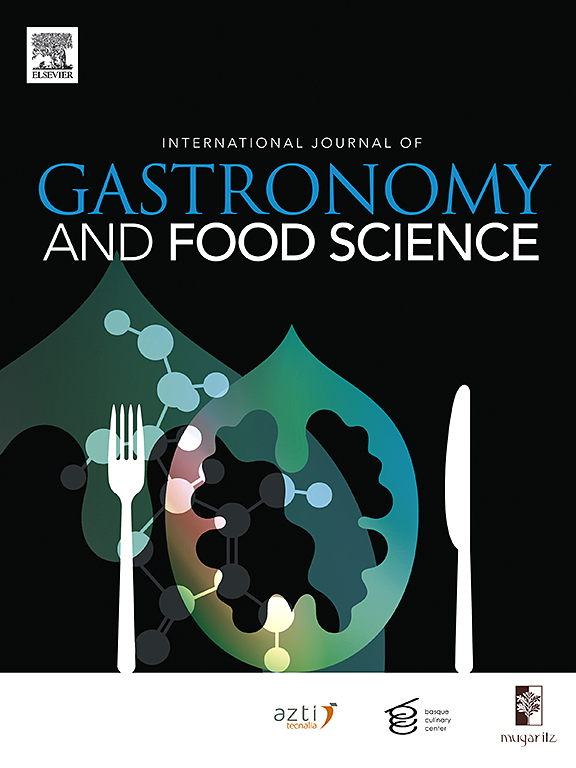甜菊醇糖苷混合物的口味特征及其在冰淇淋中的应用
IF 3.2
2区 农林科学
Q2 FOOD SCIENCE & TECHNOLOGY
International Journal of Gastronomy and Food Science
Pub Date : 2025-02-27
DOI:10.1016/j.ijgfs.2025.101143
引用次数: 0
摘要
消费者对甜菊糖的负面看法通常是由于主要甜菊糖苷(例如莱鲍迪甙(Reb) A)的苦味。本研究是通过与已知没有苦味的莱鲍迪甙D和M混合来减少莱鲍迪甙A的苦味。使用训练面板(n = 6)和电子舌来表征三种糖苷的各种混合物的味道特征。结果发现,两者之间存在显著差异(P <;0.05)的苦味和90 s时的苦味。为了评估Reb混合物的食品应用,一个消费者小组(n = 83)评估了用这种混合物加糖的冰淇淋。消费者的接受度表明,Reb A与Reb D和M的混合物可以帮助减少甜菊糖的苦味,并最终提高冰淇淋等高糖食品的喜爱度。研究结果表明,主要和次要甜菊糖苷的混合可能是减少甜菊糖和甜菊糖甜味产品的苦味的策略之一。本文章由计算机程序翻译,如有差异,请以英文原文为准。
Taste profiles of steviol glycoside blends and their application in ice cream
Negative consumer perception of stevia is often due to bitter aftertaste of major steviol glycoside (e.g., rebaudioside (Reb) A). This study was to reduce bitter aftertaste of Reb A by blending with Reb D and M, which are known to have no bitter aftertaste. Taste profiles of various blends of the three glycosides were characterized using a trained panel (n = 6) and electronic tongue. It was found that there were significant differences (P < 0.05) in bitter taste and bitter taste at 90 s among the various blends. To evaluate food applications of the Reb blends, a consumer panel (n = 83) evaluated ice cream sweetened with the blends. The consumer acceptance indicated that blends of Reb A with Reb D and M can help decrease bitterness of stevia and ultimately increase liking score in high-sugar food applications such as ice cream. The findings suggest that blends of major and minor steviol glycosides may be one of the strategies to reduce bitter aftertaste of stevia and stevia-sweetened products.
求助全文
通过发布文献求助,成功后即可免费获取论文全文。
去求助
来源期刊

International Journal of Gastronomy and Food Science
Social Sciences-Cultural Studies
CiteScore
5.30
自引率
10.50%
发文量
170
审稿时长
45 days
期刊介绍:
International Journal of Gastronomy and Food Science is a peer-reviewed journal that explicitly focuses on the interface of food science and gastronomy. Articles focusing only on food science will not be considered. This journal equally encourages both scientists and chefs to publish original scientific papers, review articles and original culinary works. We seek articles with clear evidence of this interaction. From a scientific perspective, this publication aims to become the home for research from the whole community of food science and gastronomy.
IJGFS explores all aspects related to the growing field of the interaction of gastronomy and food science, in areas such as food chemistry, food technology and culinary techniques, food microbiology, genetics, sensory science, neuroscience, psychology, culinary concepts, culinary trends, and gastronomic experience (all the elements that contribute to the appreciation and enjoyment of the meal. Also relevant is research on science-based educational programs in gastronomy, anthropology, gastronomic history and food sociology. All these areas of knowledge are crucial to gastronomy, as they contribute to a better understanding of this broad term and its practical implications for science and society.
 求助内容:
求助内容: 应助结果提醒方式:
应助结果提醒方式:


